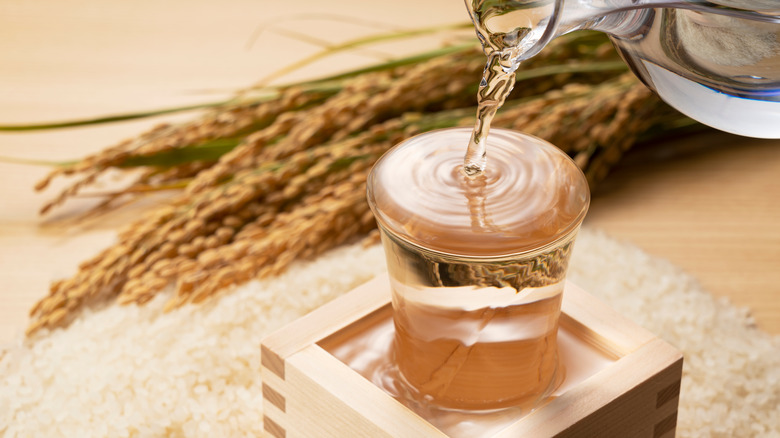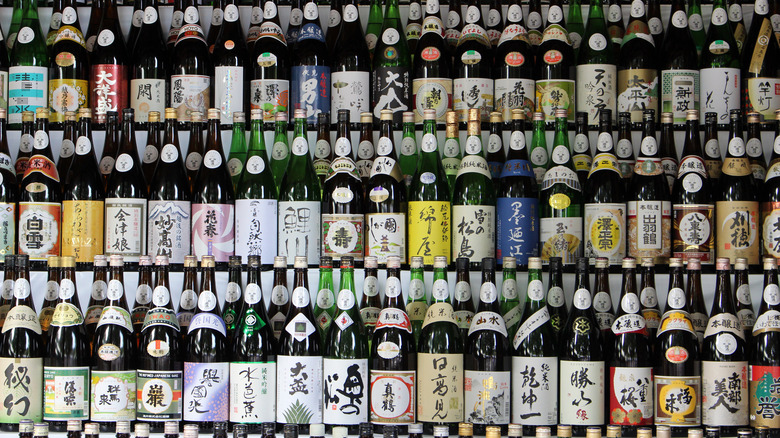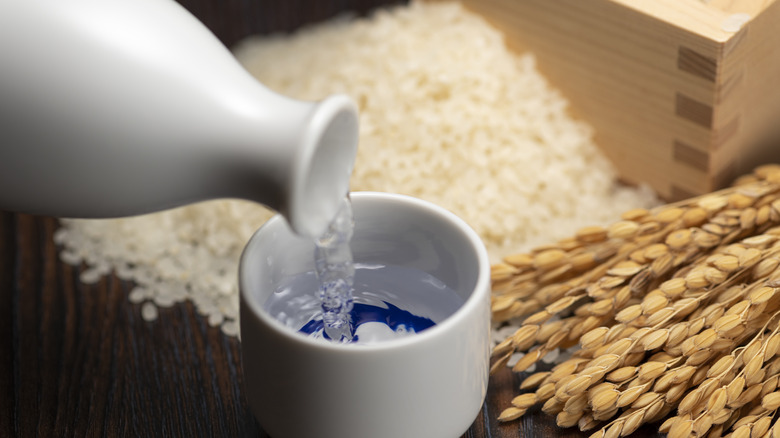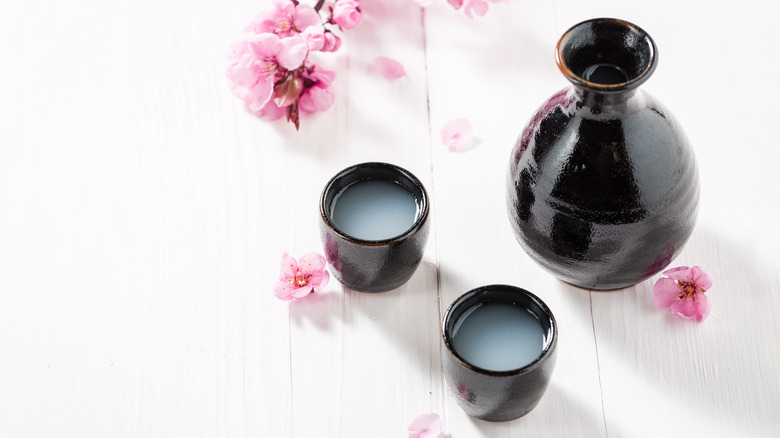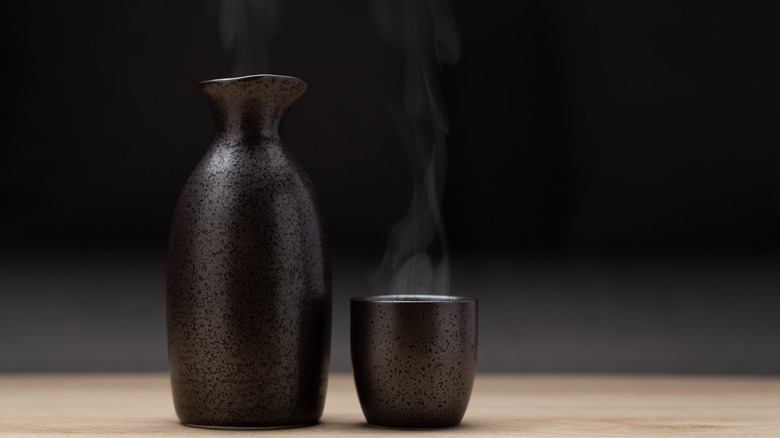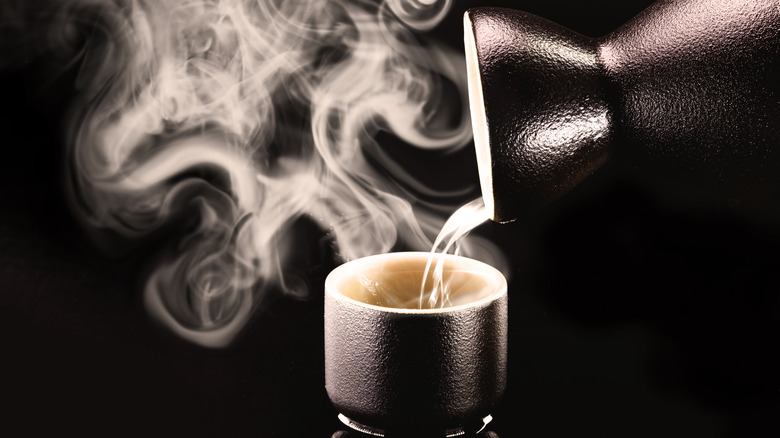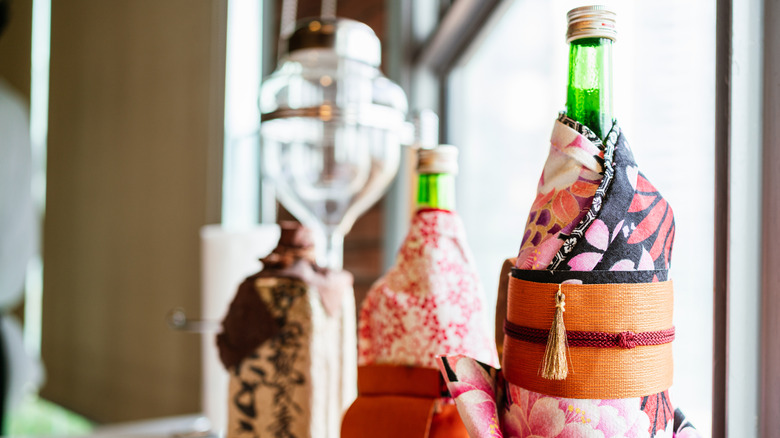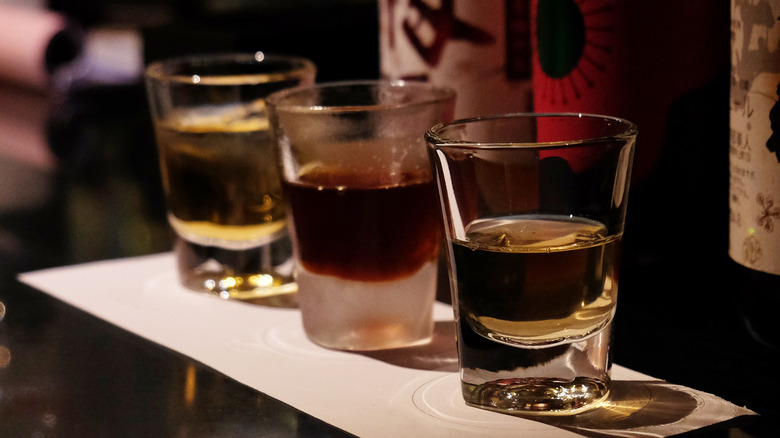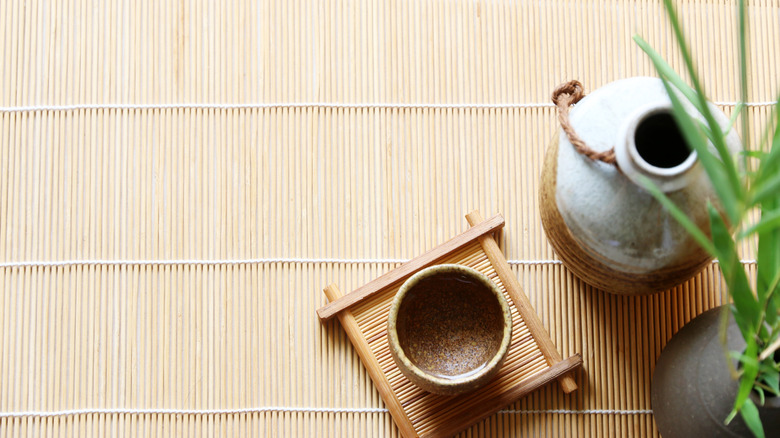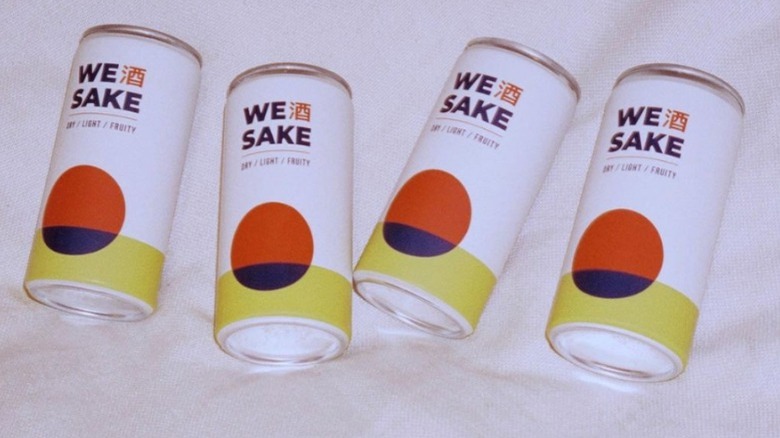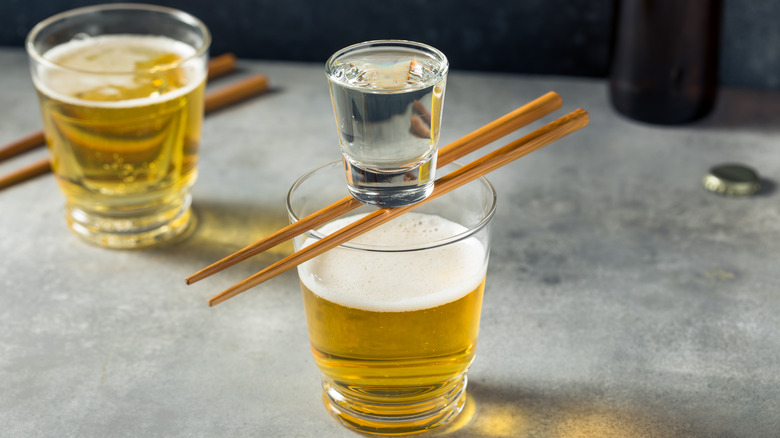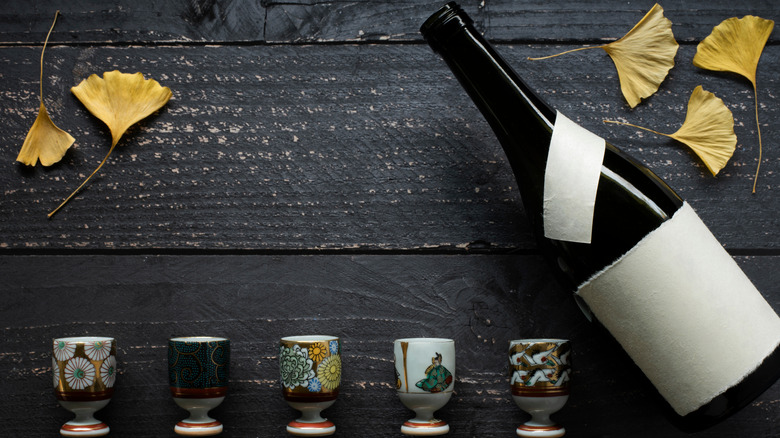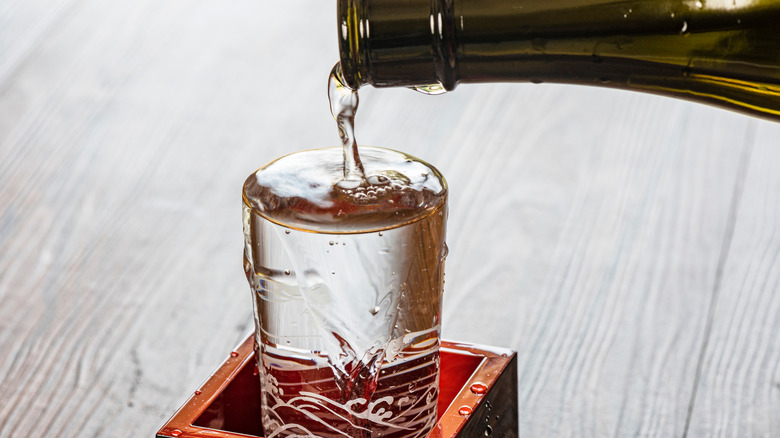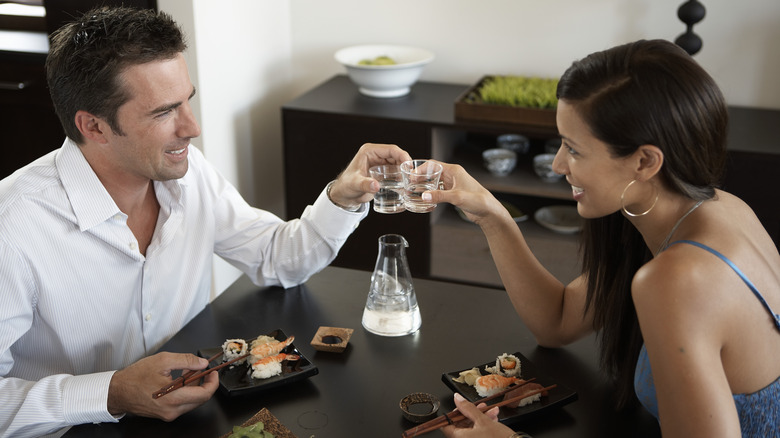13 Things To Know About Drinking Sake
Anyone who has frequented a hibachi spot or Japanese restaurant has likely encountered sake on the drink menu. Sake is a type of alcohol that, at its core, is milled rice fermented with fungus and yeast that pairs amazingly with Japanese cuisine, particularly sushi. Sake often gets mislabeled as rice wine, which isn't exactly the best way to classify it. It's a category of booze all of its own that's been around for centuries, and there sure is plenty to learn about it.
Most people likely have a limited amount of sake knowledge, if any at all. It's common for the average diner to ask for recommendations from their waiter for sake based on their personal flavor preferences. While there's a lot to learn about sake, there are a few basic facts to know that can greatly elevate you above the average drinker. It will also ensure that you order a bottle of sake that will pair perfectly with whatever food you're eating it with and won't go wasted.
We decided to provide a helpful 13-tip guide of basic things to know about drinking sake. It will make you look like an experienced drinker next time you're out for sushi, and you won't have to ask for recommendations and end up with a bottle you might not like because you know enough to pick one yourself.
Sake doesn't just refer to Japanese rice wine
As previously mentioned, Japanese rice wine is not quite an accurate way to describe any bottle of sake. In fact, if you travel to Japan, the word "sake" usually refers to any and all alcoholic beverages, whether it's beer, whiskey, or traditional sake as we know it. In Japan, sake is called "Nihon-shu" or "Sei-shu" and refers to rice fermented with fungus and yeast to make alcohol. People think it's wine because the drink resembles white wine in appearance, ranging from transparent to straw yellow in hue. It is usually mild in taste with a lot of fragrant aromas, and sake can range in flavor from dry and sweet to rich and umami-filled.
Sake also differs from wine in the way it's classified. Wine names tend to refer to the varieties of grapes that a bottle is made from. Rice and sake are not able to be categorized in the same way. The type of rice doesn't have a major impact on the way a sake tastes, rather, it's about the percentage of the grains of rice that are milled or polished. We'll discuss polishing rice later, but it's just a good way to remember that sake is a lot more distinct than just rice wine.
There are dozens of varieties of rice to make sake
Even though the milling of rice is one of the most important factors, there are several different kinds used in sake production. There are more than 300 types of rice grown in Japan, and about 100 of them (and counting) are used in the production of sake. Japanese rice is divided into rice for eating, or table rice, and rice for brewing sake. The sake rice tends to be short grain and very opaque in the center, but the grains are also larger and tend to take longer to grow. Sake rice is usually planted in the spring, and harvested in the fall.
Different types of rice can be mixed up to make one sake, but premium varieties tend to be brewed from just one strain of rice. The most common type of rice used in sake production is Yamada Nishiki. Another popular type is Gohyakumangoku, a variety that is used to make koji, which is a type of fungus used in some sake fermentation processes.
Sake has been around for thousands of years
Sake has been around for a very long time. Seriously — people have been fermenting rice and transforming it into drinkable alcohol since the process was first was invented in ancient China. It was first brought to Japan when rice cultivation made its way to the island nation, and both staples are pivotal in Japanese cuisine and beyond. Sake is one of the oldest boozy beverages that humans have ever been drinking, and that history is worth honoring by both learning about and enjoying sake.
The first record of Japanese sake existing occurred in the 3rd century CE, although it likely tastes a lot different than what you'd order at a sushi restaurant these days. Sake has also been bottled and exported from Japan since the 1870s, so it has been around for quite a while even though Americans might just be getting familiar with the drink.
Sake can be served hot or cold
There's also a common misconception that sake is only served warm, which isn't the case. It was traditionally served heated for centuries, but in recent decades, it's more popular to see it at room temperature or even chilled depending on the bottle. Heat can make or break the complex flavors of the alcohol. Sake blends that are rich and full-bodied tend to do well when heated. The element of heat can actually improve the quality of a less-than-premium bottle of sake. That isn't to say that all heated sakes are low quality — sake is meant to be enjoyed at a wide range of temperatures.
Premium sake is usually served chilled so that the delicate flavors hidden beneath the surface aren't lost in the heat. Sake can be served so cold that it starts to freeze and resemble a slushy, or it can be heated up to 140 degrees Fahrenheit. Other expressions are best enjoyed at room temperature, so it just depends on the particular bottle you're enjoying. If you're practicing your Japanese, "kan" is the word to describe heated sake while "hiya" refers to chilled sake.
There is a specific method to warming sake
For those bottles of sake that are best enjoyed warm, it isn't just as easy as throwing a mug of the stuff in the microwave for a minute and calling it a day. Sake should never be heated directly. The most common method for heating sake, which has been around for thousands of years, is to put the decanter of sake directly into warm water. It's recommended that you cover the mouth of the decanter with plastic wrap so that none of those amazing aromas escape into the air.
Sake only takes a few minutes to heat up, and leaving it on the flame for too long can lead to the alcohol evaporating and the flavors warping. Warm sake is often served in porcelain, ceramic, or bamboo containers, and it's important to make sure that whatever vessel you use to heat the rice-based alcohol can withstand a little heat.
You can buy premium bottles of sake
Like most kinds of wine or liquor, there is an entire world of premium sake that's a treasure worth exploring. The major defining factor of how premium a sake is depends on the ratio of rice that is polished from the rice. Premium sake is usually light and fruity, served chilled in a glass so as to not impact any of the flavors. It's not to say that drinking premium sake out of a ceramic cup will ruin the booze, but it is an important factor.
Two types of premium sake that you're most likely to encounter are called Ginjo and Daiginjo. Ginjo is rice that is milled 40%, leaving each grain 60% of its original size. Ginjo sake utilizes special kinds of yeast to get its flavor and involves a labor-intensive process to get the best results. Daiginjo is a type of Ginjo, but it's usually polished between 35-50%, meaning it's also a lot of work to produce. Both options are not only distinct in their flavors, but also in their fragrant nature, which is a major part of good sake.
It's important to know a few common types of sake
Ginjo and Daiginjo are two important types of sake that typically fall in the premium category, but there are several other classifications based on many factors. The two biggest distinguishing qualities between the types of sake are the amount the rice grains are polished after being harvested and if any distilled alcohol is added during the process. The rice is polished before being steamed to expose more starch and remove unwanted proteins and minerals that would impact the sake's flavor in the end. Another common type of sake is Junmai, sake that is 70% milled rice that has no added alcohol or sugars. It's only made with Japanese rice, water, and koji, that fungus we previously mentioned, and is usually served warm. One of the best types of sake that one can drink is Junmai Daiginjo, which is a Daiginjo sake that contains no added alcohol so it's extremely pure.
Another common type of sake is Honjozo, which can contain a small amount of added distilled alcohol. Honjozo has a high mill ratio, with grains needing to be milled to 70% or less of their original size. Sometimes, you might see sakes that are labeled Namazake, which means that the alcohol is not pasteurized. Finally, it's common to hear the phrase "futsuu-shu" to describe table sake which is more often used for cooking than drinking as it's not as high quality.
Sake usually is boozier than beer or wine
Because sake is often referred to as rice wine, many people might assume that the alcohol content is equally comparable. It's not too far off, but there is an important difference between the liquor levels in both drinks. Sake, in comparison to most wines, is quite boozier. The average sake has an ABV of 15-16%, whereas the average bottle of wine is between 13-15% ABV. It's definitely stronger than a beer, which typically falls in the 5% ABV range. Sake is less boozy than straight liquor like whiskey or vodka, which typically contains 40% ABV when consumed by itself.
Sake might have a little more alcohol than wine, but it's also meant to be savored. The drinking experience is not equal to crushing a 6-pack of beers in one sitting. Sake is meant to be savored, particularly with foods that help to bring out more of those hidden flavor notes in every bottle.
There are several options for drinking sake in a can
Most people who have tried sake probably drank it the traditional way — poured into tiny glasses out of a bottle or decanter. Nowadays with the never-ending growth of ready-to-drink canned cocktails, there are more ways than one to enjoy rice-derived alcohol, especially if you're not sitting down at a restaurant. A few brands have entered the market with canned options for sake like the popular Wesake co-founded by Brooklyn Peltz-Beckham. Wesake contains pure Junmai Ginjo sake that is made at a 280-year-old brewery in Kobe, Japan that the brand partnered up with. Wesake contains 13% ABV per can, meaning that four cans equate to one typical bottle of sake.
Another canned sake option is Bushido, a premium option that's a bit fruitier than Wesake, which sways dry. Bushido is a Ginjo Genshu sake that contains 18% ABV per can. Finally, for those looking for a less-boozy option, Ysidro is a sparkling sake spritz that's as refreshing as it sounds. The 6.9% ABV cans, created by a female-founded brand, featured Junmai Ginjo sake mixed with organic grapefruit and sea salt for even more flavor. All three cans are best enjoyed chilled, as are most ready-to-drink sake options on the market these days.
You aren't meant to drink sake like a shot
Even though sake is typically enjoyed in small glasses, one should never drink sake like a shot. Shooting sake is a tell-tale sign of someone who doesn't know much about the age-old alcohol. Sake is meant to be sipped like wine or tea. The exception is if you specifically order a sake bomb that features a shot of sake dropped into a beer that's meant to be drunk quickly but is far from traditional in its practices.
Sake is usually enjoyed with food, so shooting it doesn't allow you to enjoy the complex flavors like you would when sipping it slowly. Each sip is meant to expose new and exciting notes for you to discover that are lost if you shoot it without barely tasting it. Another major no-no is ever drinking sake straight from the bottle, which should be pretty self-explanatory.
There's an easy way to pre-determine if a sake is dry or sweet
IBUs are used to measure the bitterness levels in beer, and sake has a similar measuring scale to help you determine if a bottle is sweet or dry before you even crack it open. SMV is the Sake Meter Value, and it's a simple scale that classifies a bottle as dry or sweet. The true factor that is measured is the density of sake compared to water, but the flavor is what's most important to those of us drinking it.
Sweeter sakes are measured using negative numbers — the lower the number, the sweeter the sake is. Dry sakes are measured with positive numbers, with the numbers increasing as the dryness of a blend goes up. SMV is a helpful scale when trying to pick out a bottle of sake from a restaurant menu or a liquor store. However, it's not exactly a total indicator of the flavor of the sake, other factors will likely determine whether you like a bottle or not.
You're never supposed to pour your own sake
A major part of drinking culture in Japan in general, not just for drinking sake, is never pouring yourself a drink. Sake is always supposed to be poured for you, and it's expected that you will pour your fellow drinking patrons their glass of sake in return. It's a sign of good manners that promotes the natural camaraderie of drinking sake. It's not only polite but pouring drinks for fellow guests also promotes an interactive and connected experience. In Japan, it's typical for people to never serve themselves any drink whether it be liquor, beer, wine, or sake.
The Japanese word for pouring yourself a glass of sake is "Tejaku," which has the connotation of being rude attached to the phrase. It's also common practice to use both hands when both pouring sake and receiving it. In more formal settings, the host of a particular gathering will pour the first glass of sake for the guest of honor. The other attendees will pour each other glasses, and everyone is supposed to wait until everyone's cup is full before taking a sip.
Sake is best paired with food
As previously mentioned, the best way to enjoy sake is with a great meal, whether it be a multi-course sushi dinner or take-out pizza at home with friends. Like wine, there are endless dishes that sake pairs well with depending on the bottle. Unlike wine, however, there is less stress when it comes to pairing sake with food. Sake is supposed to be a supporting player of a plate of food, not the star of the show which can be the defining factor of whether a meal was good or not. Sake particularly pairs so well with food because it primes your mouth for other flavors, like a complex palate cleanser.
A good tip for pairing food and sake is to think of sake as a bowl of steamed rice. Foods like raw fish, meat in umami-rich sauces, and fried foods that you would typically eat on a bed of rice would also be great to wash down with a glass of sake. The key is experimentation when it comes to pairing food and sake, and not taking the drink too seriously if it isn't an exact match.
